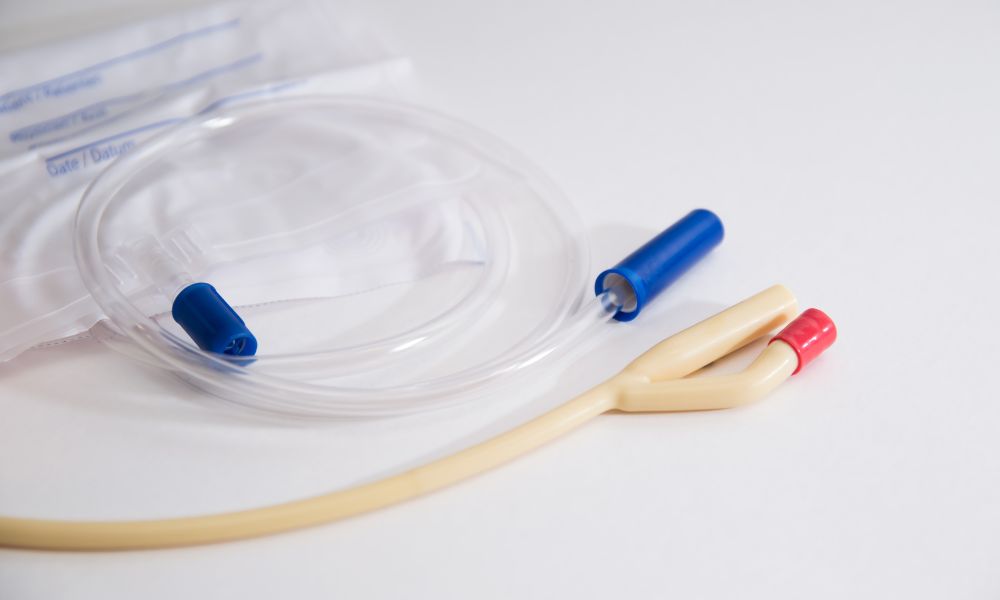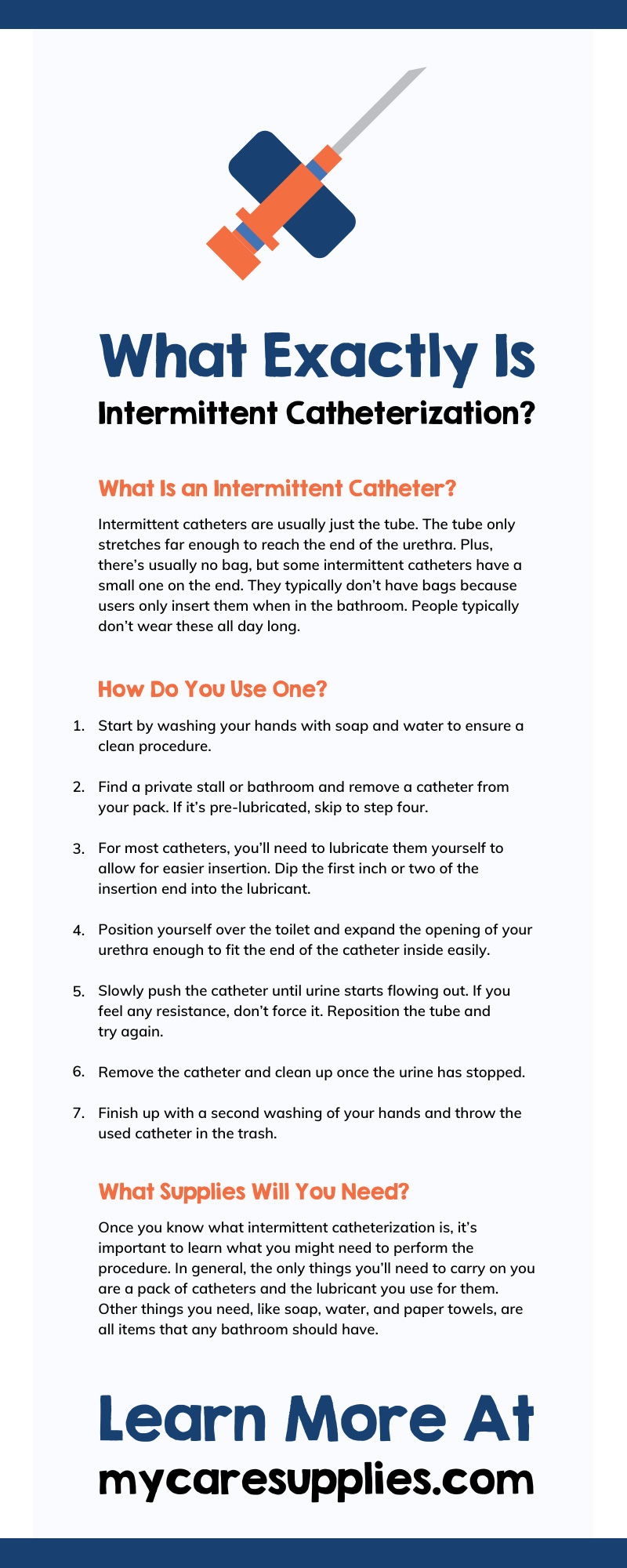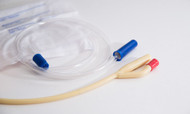What Exactly Is Intermittent Catheterization?
Posted by Jeanne Lowry on Jun 2nd 2023

When dealing with incontinence, there are many ways to handle the symptoms. One of the better options is to use a catheter, but not many people are fond of it. The reason is that catheters include a tube that goes up your urethra to reach your bladder.
However, even though many people have heard of catheters before, not many know what intermittent catheterization is. While it might sound unpleasant initially, most people with incontinence usually choose intermittent catheters, thanks to how easy they are to use and dispose of. If you aren’t sure what intermittent catheterization is, we’re here to help.
What Is an Intermittent Catheter?
When most people think of catheters, they picture a long tube connected to a bag that collects urine. This bag is typically attached to the person’s leg. That description would accurately depict an indwelling catheter. Those kinds stay inserted for long periods, whereas intermittent ones don’t.
Intermittent catheters are usually just the tube. The tube only stretches far enough to reach the end of the urethra. Plus, there’s usually no bag, but some intermittent catheters have a small one on the end. They typically don’t have bags because users only insert them when in the bathroom. People typically don’t wear these all day long.
This is what makes them such an attractive choice. You can go most of your day without wearing any incontinence protection products. Instead, you just need to insert it while in the bathroom. Of course, you’ll have to get used to inserting one multiple times a day, but most users get used to that in no time.
How Do You Use One?
So now that you better understand this type of catheter, how exactly do you use it? The general process is quite simple. While in the bathroom, insert the catheter, relieve yourself, remove it, and throw it away. However, there’s a bit more to it than that, so we’ll cover the in-depth intermittent catheterization process below:
- Start by washing your hands with soap and water to ensure a clean procedure.
- Find a private stall or bathroom and remove a catheter from your pack. If it’s pre-lubricated, skip to step four.
- For most catheters, you’ll need to lubricate them yourself to allow for easier insertion. Dip the first inch or two of the insertion end into the lubricant.
- Position yourself over the toilet and expand the opening of your urethra enough to fit the end of the catheter inside easily.
- Slowly push the catheter until urine starts flowing out. If you feel any resistance, don’t force it. Reposition the tube and try again.
- Remove the catheter and clean up once the urine has stopped.
- Finish up with a second washing of your hands and throw the used catheter in the trash.
Depending on the types of intermittent catheters you use and what your doctor recommends for your body, this process might vary a bit. However, if you’re ever unsure or forget what to do, this list of steps will be able to walk you through what to do.
What Supplies Will You Need?
Once you know what intermittent catheterization is, it’s important to learn what you might need to perform the procedure. In general, the only things you’ll need to carry on you are a pack of catheters and the lubricant you use for them.
Other things you need, like soap, water, and paper towels, are all items that any bathroom should have. However, not every bathroom is the ideal setting, so if you want to be safe, you can carry some hand sanitizer and wet wipes to ensure a sterile environment.
Which Problems Should You Be Aware Of?
One major positive of intermittent catheters is that there aren’t many complications that can occur when using them. Despite that, there are still a few potential issues to be aware of that we’ll cover for you here.
Urethral Trauma
One issue that’s more common for newer users is urethral trauma. This typically occurs when the catheter damages the inside of your urethra. Trying to force the tube in or not lubricating it properly are the biggest causes of this issue. As long as you’re careful and follow the instructions correctly, this isn’t something you’ll need to worry about.
Bladder Stones
On rare occasions, foreign debris can get caught on the end of an intermittent catheter and pushed inside the bladder. When those materials get stuck in the bladder, they can cause the formation of bladder stones.
While the responsible foreign material could include anything, stray pubic hairs are a common culprit, so be careful to keep the area clear during insertion. Sometimes, a piece of the catheter might break off and get stuck in your bladder as well. Just ensure there aren’t any cracks or deformities in your catheter before inserting it.
UTIs
More often than not, if you ever run into an issue with intermittent catheterization, it’ll most likely be a urinary tract infection (UTI). Any bacteria that gets trapped in your urethra or bladder can lead to a UTI.
This is why sterile environments are so crucial to the process. Failing to wash your hands properly before you begin is the leading cause of this issue, so if you make sure to wash them each time, the risk of a UTI will significantly diminish.
Size Issues
While this isn’t a medical issue, one last thing we wanted to talk about what using the wrong type of intermittent catheter for your body. For obvious reasons, men and women have different urethra lengths.
That means if you don’t buy specific male intermittent catheters, the tube won’t be able to reach your bladder. Women could theoretically use a men’s catheter, but it’s still better to ensure you get the best type for your gender.
Is Intermittent Catheterization Best for You?
By now, you likely have a pretty good idea if intermittent catheterization is the right option for you, but we’ll go over which type of people they’re best for. In general, anyone who’s always on the go will benefit from an intermittent catheter since the usage process won’t take up much of your time.
Also, those who are active or in sports will prefer intermittent catheters since they won’t have them in the way while they’re doing their strenuous activities. Some people just genuinely don’t like the feeling of a tube in their urethra for long periods. These catheters help fix that problem as well. Worst case scenario, if you try them out and discover they’re not for you, switching to a different type of catheter won’t be a big problem for you now that you’re used to them.


